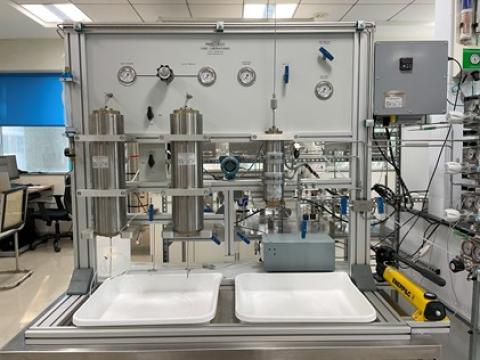
External users: registration to be carried out only through I-STEM portal
Additional information about sample and analysis details should be filled in the pdf form provided in the I-STEM portal under “DOWNLOAD CSRF”
Internal users (IITB): registration to be carried out only through DRONA portal
Additional information about sample and analysis details should be filled in the pdf form provided here.
.
Category
- Material Characterization » Mechanical Characterisation
Booking Details
Facility Management Team and Location
Facility Features, Working Principle and Specifications
Facility Description
The model is designed for the precise evaluation of permeable rock samples under multiphase flow conditions, allowing researchers to assess the rock's ability to transmit fluids of different phases. This instrument facilitates the accurate characterisation of rock permeability, a key parameter in understanding fluid behavior in geological formations. Equipped with SmartPREL software, the system enables sophisticated data acquisition and analysis, adhering to universal standards for permeability testing. This setup is indispensable for studies related to reservoir engineering, energy resource management, and environmental geosciences.
Multiphase relative permeability describes the ability of different fluid phases (e.g., oil, water, and gas) to flow simultaneously through a porous medium. It is defined as the ratio of a phase’s effective permeability to the absolute permeability of the rock. The principle is based on the fact that when multiple fluids coexist, they compete for pore space, affecting flow behavior. Relative permeability is a function of fluid saturation, meaning that as the saturation of one phase increases, the permeability of the other phase decreases. Wettability plays a crucial role, determining which phase preferentially occupies the smaller pores. Capillary pressure also influences fluid distribution, impacting flow resistance. Additionally, residual saturation occurs when a portion of a phase remains trapped due to capillary forces, limiting complete displacement. Experimental determination of relative permeability is conducted through core flooding tests, where fluids are injected into rock samples under controlled conditions, and flow rates are measured. Empirical models such as Corey’s equations and the Brooks-Corey model help predict permeability variations.
Maximum Overburden Pressure: 10000 psi
Maximum Back Pressure: 6000 psi
Maximum Flowrate (Liquid): 10 ml/min
Sample Preparation, User Instructions and Precautionary Measures
Cylindrical core sample (1.5 inches Diameter and 3 inches Height)
Charges for Analytical Services in Different Categories
Category | Multiphase Relative Permeability Test |
IITB TAs on specific instruments | 5000 |
IIT Bombay | 10000 |
Other Academic Institutes | 20000 + 18% GST |
National labs | 50000 + 18% GST |
Industries | 100000 + 18% GST |
Start-up (SINE incubation) | 50000 + 18% GST |
Monash IIT B | 10000 + 18% GST |
SAARCS countries & African countries (Low-Income Countries)
| 50000 (Academic) |
100000 (Industries) | |
For Other countries | 100000 (Academic) |
200000 (Industries) |
Applications
Reservoir Engineering
Energy Resource Management
Environmental Geosciences
Sample Details
CO2, N2
